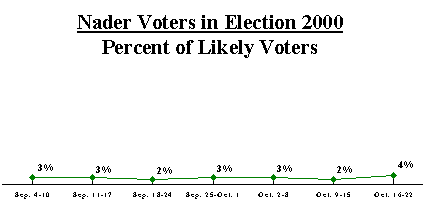GALLUP NEWS SERVICE
PRINCETON, NJ -- Green Party candidate Ralph Nader is the third-party candidate drawing the most attention from the news media this year, although, on a national basis, Nader is consistently drawing between 2% and 4% of the public's support, as the chart below shows.

The table below represents the percentage of the vote Nader receives in a combined sample of over 1,600 interviews with likely voters, conducted from October 16-22, 2000.
Now, suppose that the presidential election were being held today, and it included Al Gore and Joe Lieberman as the Democratic candidates, George W. Bush and Dick Cheney as the Republican candidates, Pat Buchanan and Ezola Foster as the Reform Party candidates, and Ralph Nader and Winona LaDuke as the Green Party candidates. Would you vote for -- Al Gore and Joe Lieberman, the Democrats, George W. Bush and Dick Cheney, the Republican candidates, Pat Buchanan and Ezola Foster, the Reform Party candidates, or Ralph Nader and Winona LaDuke, the Green Party candidates?
As of today, do you lean toward Gore and Lieberman, the Democrats, Bush and Cheney, the Republicans, Buchanan and Foster, the Reform Party candidates, or Nader and LaDuke, the Green Party candidates?
|
Nader/ |
|
|
October 16-22, 2000 |
% |
|
TOTAL |
4 |
|
Independent |
10 |
|
Liberal |
6 |
|
Some college |
6 |
|
Moderate |
5 |
|
West |
5 |
|
East |
5 |
|
18-29 |
5 |
|
Nonwhite |
5 |
|
Midwest |
4 |
|
Men |
4 |
|
Women |
4 |
|
College graduate/postgraduate study |
4 |
|
White |
4 |
|
30-49 |
4 |
|
50+ |
4 |
|
South |
3 |
|
No college |
2 |
|
Conservative |
2 |
|
Democrat |
2 |
|
Republican |
1 |
Nader's support rises to 10% among those who say they are not specifically affiliated with either the Republican or Democratic parties. Also, those who say they have a more liberal ideology are more willing to vote for Nader (6%) than are those who have a more conservative worldview (2%). Five percent of Americans claiming to be moderate support Nader's bid for the presidency. Just 2% of those with a high school education or less say they support him, compared to 6% with some college and 4% for those who have graduated from college or have postgraduate education.
Survey Methods
Latest results are based on telephone interviews with -- 1,690 -- likely voters, aged 18+, conducted October 16-22, 2000. For results based on the total sample of likely voters, one can say with 95% confidence that the margin of sampling error is +/- 3 percentage points. In addition to sampling error, question wording and practical difficulties in conducting surveys can introduce error or bias into the findings of public opinion polls.
